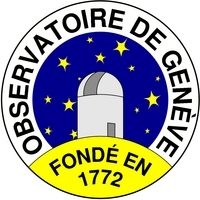
| INTEGRALPlanckGaiaPOLARCHEOPSEuclidATHENA |
| HEAVENSFACTCTALOFTSPICAJEM-EUSOXIPEeXTPTheseus |
| XRISMMAGBOUNDSMARTNet |
| ISDCCDCI |
| Data Centre for Astrophysics Astronomy Department of the University of Geneva |
| ISDC Seminar |
Evanthia Hatziminaoglou
Laboratoire d'Astrophysique de Toulouse
Quasars: Cosmic Laboratories and Cosmological Probes
Abstract. Our understanding of the nature of AGN physics implies events of a dramatic importance. Nowadays, the idea that the source that nourishes the AGN is accretion onto a super massive black hole seems to satisfy the majority of the people working in this field. If this idea is realistic, their principle properties depend upon very "exotic" physics. The modeling of the accretion disk implies plasma physics, their X-ray and gamma-ray emission invokes high-energy physics and all the above has to be put together with a lot of patience, humor and imagination.
AGN optical and UV spectra indicate the state of the accretion disk and the matter distribution in space via the Lyman forest, their X-ray spectra give hints about the structure of the accretion disk, infrared observations provide information about the dusty material around them and simultaneous multi-wavelength observations of these objects can cast light on dark points such as the unification scheme or the variability.
Apart from being interesting objects as individual entities, quasars also offer the opportunity of assembling relatively large and unbiased samples of "standard candles" since their statistical properties do not seem to depend on the redshift. Once their luminosity function modeled, geometrical cosmological tests such as the V/Vmax can be applied in order to define the values of the cosmological parameters. Furthermore, their contribution to the overall UV, X-ray and gamma-ray background can be estimated, as well as their role in the reionization history of the Universe.







